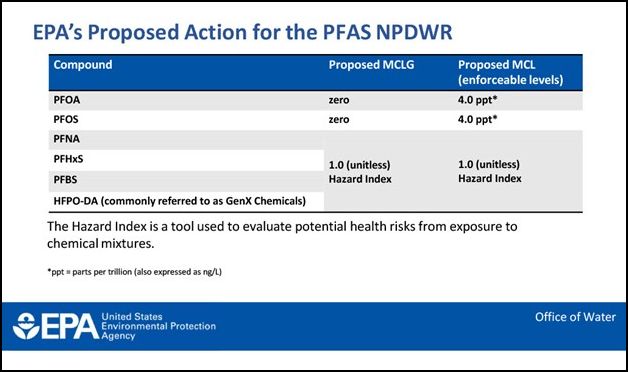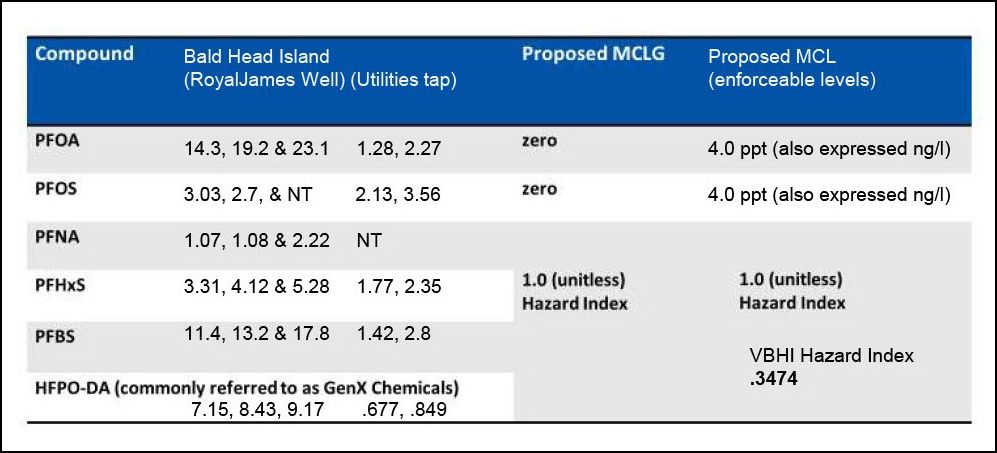Emerging Contaminants
As technology continues to evolve and improve, laboratories can identify and detect new compounds that were previously unknown. When found in the drinking water supply, these new chemicals are known as “emerging contaminants.”
Emerging contaminants create a challenge for drinking water providers because they are unregulated, and little is known about their potential risks to human health and the environment.
TEST RESULTS
BACKGROUND
Since the emerging contaminants (GenX/PFAS) issue with drinking water sourced from the Cape Fear River began in 2018, nothing has changed with the sources of the Village’s drinking water. The primary source of the island’s drinking water is island wells. The Village uses a reverse osmosis (RO) system to treat its water. This method successfully removes the emerging contaminants. While the island’s water is supplemented with treated water from Brunswick County, the water it receives comes from the NC 211 plant also draws from wells and is treated. The NC 211 plant water is supplemented with treated water from Brunswick County’s Northwest Plant. The Northwest Plant’s water source is the Cape Fear River. This blended and treated water supplements Bald Head Island’s water during high use periods and is blended with the island’s treated water. Through this process, a very dilute quantity of treated Cape Fear River water is combined with the island’s drinking water.
When tested for emerging contaminants in 2018, the concentration in the island’s potable water was slightly more than 2 parts per trillion (ppt). The human consumption threshold at the time was 140 ppt (it is currently 4 ppt). With reductions in source contamination since that time, the concentrations throughout the river and in the treatment system are well below the 140 ppt threshold.
MAY 2022
In May 2022, the Village announced that it was aware of a letter that Bald Head Island property owners were receiving from Chemours in regard to a residential drinking water well information request. The request asked for the property owner’s source of drinking water and states that Chemours is in the process of identifying private drinking water wells for testing.
There are three private drinking water wells on the island. To make sure these private well owners are aware of the testing, the Village reached out to them. Property owners could also have responded to Chemours’ request if they wished to do so.
To find out more information about why Chemours is testing the wells, please go to the NC Department of Environmental Quality’s “Well Sampling Information for Lower Cape Fear Area Residents” webpage HERE.
JUNE 2022
On June 15, 2022, the U.S. EPA issued lifetime Health Advisory Levels for four PFAS compounds: GenX, PFAS, PFOA, and PFBS. These advisories are not enforceable standards for drinking water but were issued to provide information to water providers and the public.
JUNE 2023
On June 9, 2023, the Village announced that it had joined a Multi-District Litigation federal class action complaint against the manufacturers of products that contain per- and poly-fluoroalkyl substances (or “PFAS”), a class of manmade chemical compounds used in a variety of industrial and consumer products. One of those products is a fire-fighting foam that was used for decades at airports and military installations (AFFF – aqueous film-forming foam).
View the full announcement HERE.
JULY 2023
At the July 21, 2023, Village Council meeting, JP McCann, Public Services Director, gave an update on emerging contaminants (this information was reported in the Village’s Voice e-newsletter). Mr. McCann has been attending NC Department of Environmental Quality (NCDEQ) workshops locally for the last two years regarding this topic and shared information about the Environmental Protection Agency’s policy proposals and the latest on the Village’s response to emerging contaminants.
EPA’s Response – Mr. McCann reported that the EPA is proposing a National Primary Drinking Water Regulation (NPDWR) to establish legally enforceable levels, called Maximum Contaminant Levels (MCLs) for six Per-and Polyfluorinated Substances (PFAS) in drinking water. The EPA is also proposing health-based, non-enforceable Maximum Contaminant Level Goals (MCLGs) for these six PFAS. These MCLGs are the maximum level of contaminant in drinking water where there are no known or anticipated negative health effects allowing for a margin of safety.
The proposed MCLG and MCL (enforceable levels) can be viewed below.

Village’s Response – The State approached the Village about testing the island’s drinking water and tests were performed this past spring 2023 of the Royal James well. The results are shown below. The numbers on the left are the test results of the water coming straight from the well, the numbers on the right are the test results of the water coming from the tap at the time of the testing (this would be water from all sources that the Village’s water system was pulling from at the time of testing). All results received from this testing would fall below EPA’s proposed enforceable levels.

Mr. McCann emphasized that this is a snapshot in time, the results can change. This is because the Village pulls from different wells over time and adds Brunswick County treated water at various amounts during peak usage periods. He explained that as more testing is performed the Village will get a better understanding of what sources impact the results. The frequency of testing required for local water systems is likely to come out of the EPA’s guidance. The current proposed levels are also a snapshot and are subject to change. Mr. McCann indicated that the proposed levels have gone from 140 ppt and 70 ppt to the currently proposed levels of 4.0 ppt and 1.0 Hazard Index (unitless).
Mr. McCann reported that the Village would be performing additional testing that will concentrate on water from the wells closest to the river and intake water coming from Brunswick County and then a tap result. The Village is also being proactive by putting in pre-filters and is seeking to modify them to include additional filters such as GAC (granular activated carbon) filtration.
The Village will provide updates as more test results are received and as the EPA’s regulations become final.
View all the EPA slides HERE.
AUGUST 2023
At the August 18, 2023, Village Council meeting, JP McCann, Public Services Director, gave an update on emerging contaminants (this information was reported in the Village’s Voice e-newsletter). He indicated that all 16 wells will be tested going forward. He said he is expecting test results to come in for three wells, the County water line, and taps at the Public Safety building.
Mr. McCann answered questions about the Village’s use of water from Brunswick County. He said that usage depends on the time of the year and is based on demand. The Village uses the County water most in the months of June, July, and August. He emphasized that the testing of the water is a snapshot in time and that the Village’s water meets EPA standards with the current filters in place and is well below maximum thresholds for emerging contaminants. The raw water testing indicates that there are traces of the contaminants and the filters in place are working to result in finished water that is well within EPA standards.
SEPTEMBER 2023
At the September 15, 2023, Village Council Meeting, Jae Kim, Assistant Village Manager, reported on the Village’s Asset & Inventory Assessment Grant and its specific tasks, one task includes the following:
A Fall 23 DWSRF (Drinking Water State Revolving Fund) Application for a planning development and construction project. This consists of a water plan (filtering wells, pre-filtering prior to RO process) and lowering/eliminating contaminant (PFAS) from discharge effluent from the wastewater treatment plant to lagoons (ex: activating carbons in effluent).
APRIL 2024
On April 10, 2024, the EPA issued the first-ever national, legally enforceable drinking water standard to protect communities from exposure to PFAS. This rule sets limits for five individual PFAS: PFOA, PFOS, PFNA, PFHxS, and HFPO-DA (also known as “GenX Chemicals”) – the ones that the Village has been looking closely at over the last year.
The EPA will be working with state co-regulators in supporting water systems and local officials to implement this rule.
According to Coastal Review, an estimated 6 to 10% of 66,000 drinking water systems in the U.S. have three years to comply. In North Carolina, a combined more than 300 municipal and small water systems sampled in 2022 had PFAS detections above the newly established maximum contaminant levels, or MCLs, according to the North Carolina Department of Environmental Quality. Utilities that have drinking water contaminated with PFAS exceeding the MCLs will be given five years to integrate technology at their facilities to reduce the amounts of chemical compounds.
In follow-up to the EPA’s announcement, the NC Department of Environmental Quality released this statement on the next steps.
AUGUST 2024
To address the air emissions of PFAS, or “forever chemicals,” three state environmental agencies submitted a petition to the U.S. Environmental Protection Agency to add four specific PFAS chemicals to the list of Hazardous Air Pollutants (HAPs) under the Clean Air Act. PFAS air emissions affect surface water, groundwater, and soil, and result in the contamination of public and private drinking water sources.
For more information, read the August 29, 2024 release from the NC Department of Environmental Quality HERE.
As the Village continues to perform tests and take further actions those will be posted on this webpage.
If you have any questions, please contact Carin Faulkner, Public Information Officer at (910) 457-9700 ext. 1025 or public.information@villagebhi.org.
